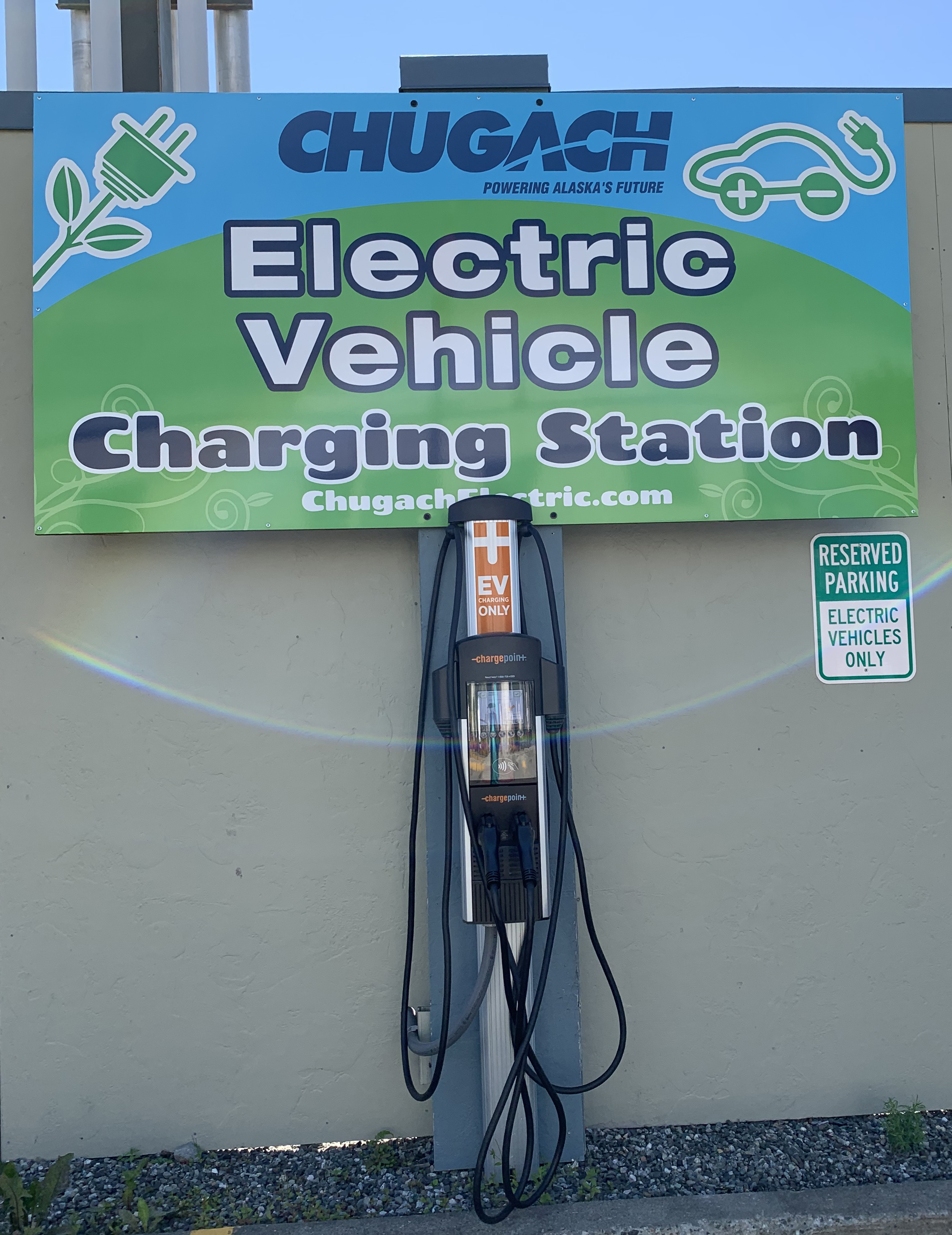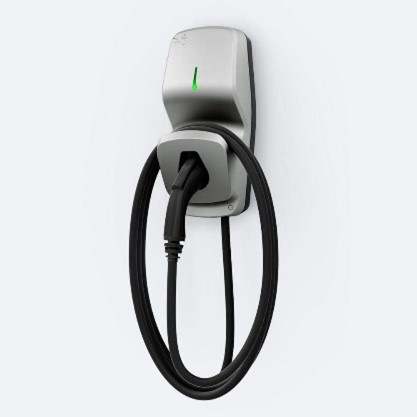About Electric Vehicles
There are more electric vehicles (EVs) on the road every year, including in Alaska. There are two types of EVs that charge from the electric grid. Battery Electric Vehicles (BEV) run solely on electricity stored in batteries, commonly with a range of 200-350 miles or more. Plug-in Hybrid Electric Vehicles (PHEV) have a smaller battery and modest all-electric range (often 25-40 miles) as well as an internal combustion drivetrain.
EV charging is generally classified in three main categories:
- Level 1 Is slow charging usually at home from a standard 120-volt outlet. Typical power is 1-1.8 kW and can add 2-5 miles of range per hour.
- Level 2 Is faster charging at home, commercial, or public sites with a 208/240-volt outlet or hardwired EV charger. Typical power is 5-19 kW and can add 10-30 miles of range per hour.
- Level 3 Is DC fast charging at public sites or commercial sites. Typical power is 50-250 kW or more and can add 150-350+ miles of range per hour.
Check out the EV Terminology and Resources brochure for more information on EV terminology.
EV Incentives
Chugach offers electric vehicle (EV) charging incentive programs to promote the use of EVs in Alaska. The programs help individuals and businesses establish charging at home, at workplaces, for fleet vehicles, and for public use within the Chugach service area by providing a bill credit after installation.
The bill credits amounts vary by program and are listed in the overview below.
|
Program Name |
Incentive |
Charging Level |
Max per Account |
|
Residential |
$200 |
L2 (208-240 volt) |
2 |
|
Commercial – Level 2 |
Up to $1,000 |
L2 (208-240 volt) |
2 |
|
Commercial – DC Fast Charging |
Up to $5,000 |
L3 DC Fast Charging |
2 |
Applicants may apply for more than one program per location, but an individual charger cannot receive funding more than once from Chugach. An applicant may receive funding from other sources without affecting their eligibility under a Chugach program.
Below are links to current Chugach EV incentive programs.
EV Program Contacts:
Mark Henspeter at mark_henspeter@chugachelectric.com, (907)762-4210, or Sean Skaling at sean_skaling@chugachelectric.com, (907)762-4192.
Benefits of Electrification
Using electricity as a transportation fuel provides a number of benefits. First, “fueling” a vehicle with electricity is significantly less expensive than fueling with liquid fuels. Another is reduced transportation emissions such as carbon dioxide, which are 60-70 percent less than gasoline when powered by Chugach. A third benefit is that the use of electricity for EV charging helps spread the fixed costs of a utility like Chugach across greater sales, which puts downward pressure on members’ electric rates.
EVs in Alaska
Every six months Chugach conducts a count of electric vehicles (both all-electric and plug-in hybrids) registered in Alaska. The number of registered EVs in Alaska and in the Municipality of Anchorage (MOA) has risen steadily in recent years, as shown below.


There are now a wide variety of BEV and PHEVs registered in the MOA, and the total number of EVs is the fastest growing population in the state, at approximately 100 new EVs per month. At the beginning of 2024 there were over 1,500 plug-in electric vehicles registered within the MOA. The most common BEV brand is Tesla at nearly half of all BEVs, followed by Chevy. The most common PHEV brand in the MOA is BMW, followed by Ford. The most popular 2023 model year electric vehicles were the Tesla Model Y, Tesla Model 3, and Chevy Bolt.

Cost of Charging an EV
The cost* of charging an EV is less than half the cost of fueling an internal combustion vehicle when fuel cost is $3.75 per gallon and electricity is $0.20 per kWh, approximately Chugach’s residential rate.
Try Chugach’s EV Calculator to compare the cost of charging an EV to the cost of fueling a gasoline vehicle. It also calculates carbon dioxide emissions reduction based on Chugach’s generation mix of natural gas, hydro and wind.
The Alaska Electric Vehicle Calculator developed by the Alaska Center for Energy and Power provides additional information on energy costs around Alaska and seasonal energy consumption.
*Assumes average electric vehicle efficiency of 2.9 miles per kWh and the average gasoline vehicle efficiency of 26.0 miles per gallon.
EV Emissions
The emissions from driving an EV are produced at the power plants where electricity is generated, rather than being emitted from the vehicle directly. Chugach has a generation portfolio comprised of natural gas, hydro, and wind. An electric vehicle powered by the Chugach system is responsible for approximately 66% less carbon dioxide than an average-efficiency gasoline-powered passenger vehicle. In addition, an EV emits no cold-start carbon monoxide or other pollutants. Chugach members who have rooftop solar panels can further reduce the carbon emissions of driving an EV.
Efficiency of EVs
The main reason for the low cost per mile is due to the efficiency of the electric drive system compared to an internal combustion engine drivetrain. According to the US Department of Energy, about 12 to 30% of the energy in the hydrocarbon fuel is converted to forward momentum in an internal combustion engine vehicle, compared to 60 to 73% of the electricity in an EV battery. An EV also recaptures energy while braking, which can increase total efficiency to over 90%.
Seasonal variation in temperature will affect the amount of energy consumed by an EV for heating and cooling. Efficiency during the winter is typically 20-30% lower for many modern EVs since electricity is used to maintain the battery temperature and heat the cabin. EVs are generally most efficient around town where speeds are lower, and more energy is regenerated in stop-and-go traffic. During cold winter months efficiency may drop around town since extra energy is used to warm the cabin on frequent short trips. Parking in a garage helps to reduce the energy used for heat.
The US Department of Energy provides interactive graphics that provide energy requirements for different driving conditions.
How to Charge at Home
The first step when considering EV charging at home is to understand your typical driving behavior, such as how many miles you typically drive per day, and where you plan to park your EV. This will inform your investment in EV charging equipment and electrical upgrades to meet your needs. The power of electric vehicle supply equipment (EVSE) is determined by the circuit voltage and available amperage. Voltage is typically either 120v or 208/240v and amperage is determined by the circuit breaker in your electrical panel and wiring, typically ranging from 20A to 80A.
You can charge your EV virtually anywhere. A mobile charger is essentially an extension cord that you can use to charge from a standard outlet. Level 1 charging from a 120-volt outlet can add 3 to 5 miles of range per hour, and an overnight charge may be sufficient to cover daily driving.
Level 2 charging (208-240-volt) is faster and adds about 20 to 40 miles of range per hour. You can either use a mobile charger and a 240-volt outlet near your vehicle or hardwire a dedicated EV charger. Many homes already have a 240-volt outlet in the garage that can be used for EV charging, although a hardwired charger can provide more power than an outlet.
|
Example of a mobile charger |
Example of a hardwired charger |
A commuter driving more than 1,000 miles per month may need a dedicated high-amperage charger, while a driver who mostly uses their EV for short trips around town may find using a mobile charger plugged into an existing outlet is sufficient. The efficiency of your EV is also important when considering your charging needs. A smaller EV with an efficiency of 4 miles per kilowatt-hour (4 mi/kWh) charging at 24 amps will add range at the same rate as an electric truck with an efficiency of 2 mi/kWh charging at 48 amps. Chugach encourages members interested in purchasing an EV to first talk with an electrician about existing wiring in their home or garage and discuss upgrades or reconfiguration of existing circuits to support EV charging needs.
From electric grid perspective, the best time to charge is overnight after 10 pm when demand on the Chugach system is lower. Most EVs can be programed to start charging at a specified time, or to reach a target state of charge by a certain time. Chugach encourages EV drivers to try out the scheduled charging feature on their vehicle and determine what makes sense for their needs. Many EVs default to start charging at midnight, which can create a local spike in electric load if there are multiple EVs in your neighborhood that begin charging simultaneously. Choosing a target completion time before 8am can help distribute charging across off-peak hours.
Public Charging Stations
There are over a dozen charging stations in the Municipality of Anchorage, and the number is increasing steadily. Chugach helped fund six of the first stations in Anchorage and Girdwood and continues to support new EV charging infrastructure. The Dimond Center hosts the city’s first DC fast charger capable of charging at more than 60 kW.
One of the most frequently used apps to find charging stations is called PlugShare. The app identifies the charger locations near you and provides information including the type of charger, types and numbers of charging ports, cost, user comments, and photos. More detailed information is sometimes available for networked chargers. For example, the ChargePoint app provides more detail about their chargers, such as availability and charge complete notifications, if enabled.
Below is the PlugShare.com map of publicly available charging stations in the Anchorage area. There are many more non-public charging stations intended for employees, fleets, or other private purposes. Zoom out to see other chargers along Alaska’s highways, including many DC fast chargers now in operation and more coming soon.
Charging at Chugach
Chugach has installed two Level 2 ChargePoint EV charging stations which are available for public use in the parking lots at its south headquarters at 5601 Electron Drive and north district building at 1040 E 1st Avenue. While there is currently no charge to use them, charging is limited to 8 hours per vehicle per week. Drivers need to first download the ChargePoint app or sign up for an account at chargepoint.com or dial the number on the charger.
How to charge an EV with ChargePoint

ADDITIONAL INFORMATION CAN BE FOUND AT THE LINKS PROVIDED BELOW:
Electric vehicles on the market
Other
- Charging Stations
- Federal Income Tax Credit for purchasing an EV
- Charging Station Federal Tax Credit
- All Federal and State Incentives
- Alaska’s NEVI funding
- Choosing A Home Charger: How Many Amps Do You Need?




Follow us for the latest service updates
Twitter Facebook YouTube